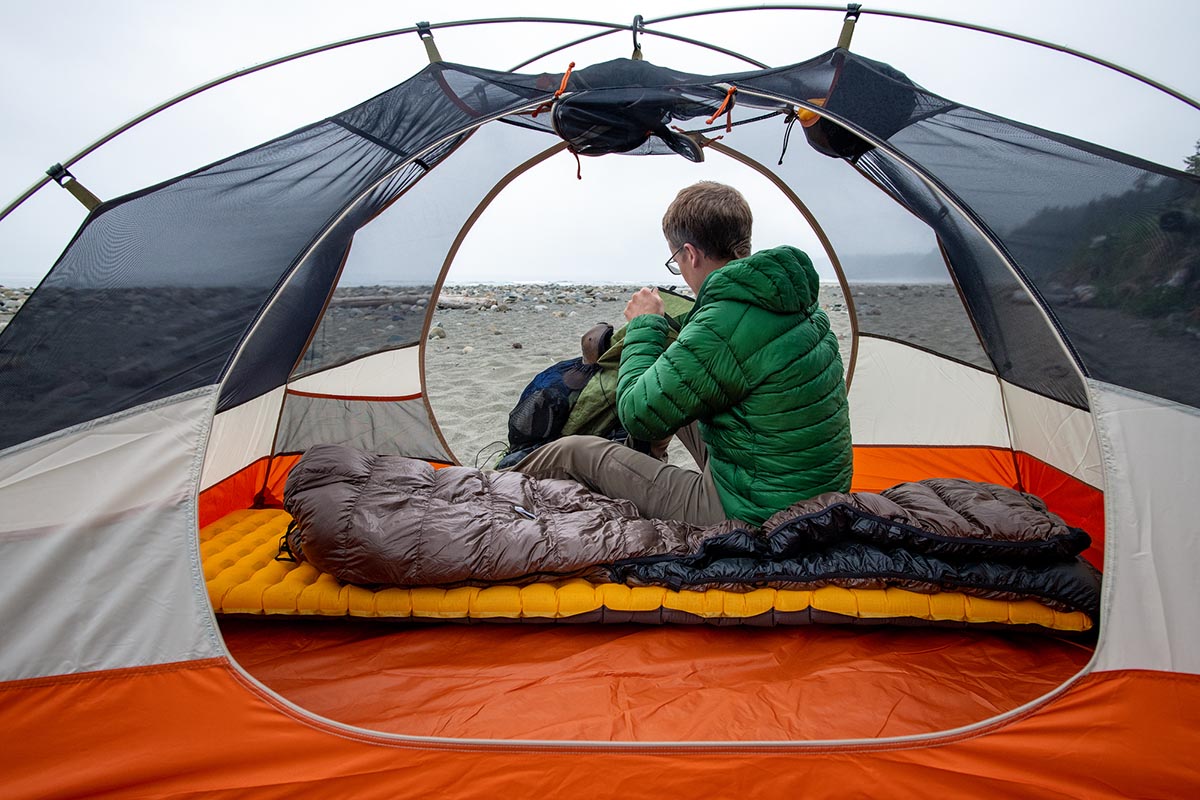
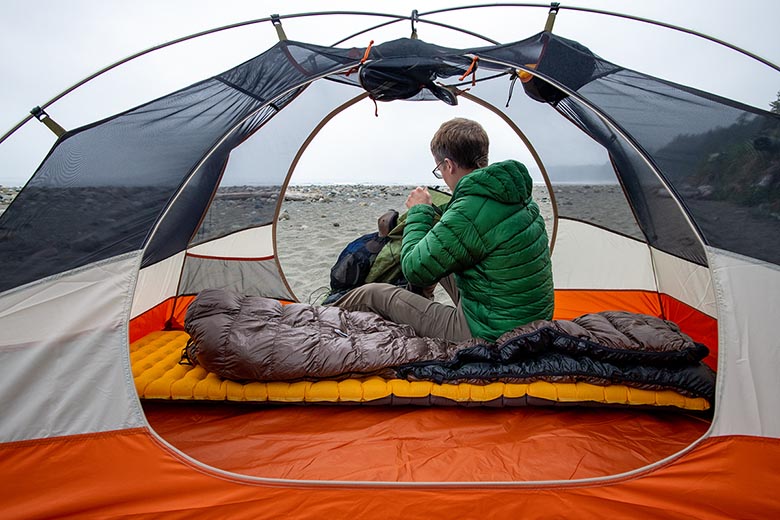
Switchback Travel (Jason Hummel)
A good night’s sleep on a backpacking trip used to be a rarity, but today’s sleeping pads are much improved over their predecessors. Comfort is better than ever with advanced baffling and cell designs, weight and packed size continue to drop, and you can get all the insulation and warmth you need for cold weather. After many nights sleeping under the stars all over the world—from Southern Patagonia to East Africa—we narrowed in on the best backpacking sleeping pads of 2025. Selecting 17 standouts for everyone from beginners to veteran backpackers, we included a diverse range of air, self-inflating, and foam models for all types of adventures. For more background information, see our comparison table and buying advice below the picks. And for campers who care more about comfort than weight and packability, we’ve also put together a list of the best camping mattresses.
Editor’s note: We updated this guide on April 21, 2024, to remove the discontinued Therm-a-Rest ProLite Plus and add the Therm-a-Rest NeoLoft. We also added more information about our testing practices, shared new photos in our buying advice from recent testing trips, and ensured all information was up-to-date with current specs, colorways, and designs.
 Category: Air pad
Category: Air pad
Weight: 13 oz.
Thickness: 3 in.
R-value: 4.5
What we like: Great warmth-to-weight ratio for 3-season backpacking; new, quieter design.
What we don’t: Pricey; not as easy to fill as the Tensor below.
Therm-a-Rest is synonymous with quality backpacking pads, and the NeoAir XLite NXT is their leading lightweight model. For many people and uses, it’s the whole package: The XLite is comfortable with 3-inch thick baffling, features relatively durable 30-denier fabric, and has a decently high R-value of 4.5. The pad also weighs just 13 ounces and stuffs down impressively small, making it a premium choice for weight-conscious hikers, climbers, and more. The most recent "NXT" version uses new technology to deliver a quieter sleep, which addresses one of our main complaints with the older version. All told, the NeoAir XLite NXT is Therm-a-Rest’s most uncompromised offering yet. It was one of our editor's steed of choice for each trail of the Triple Crown (AT, PCT, and CDT), and kept him cozy through a full spectrum of conditions and climates. He simply won't set off on a long trek with anything else (unless it's a full-blown winter excursion).
The Therm-a-Rest NeoAir XLite NXT is undeniably expensive, but you’d be hard-pressed to find another pad that offers the same amount of warmth and comfort at such a low weight. If you’re serious about backpacking, often find yourself out in the shoulder seasons, and want the best 3-season pad money can buy—this is it. On the other hand, if your backpacking trips are characterized by warm, summery conditions, a lower R-value pad can save you some money (that said, very few can compete with the Therm-a-Rest in terms of weight). And when choosing your Therm-a-Rest, keep size in mind: The mummy-shaped XLite NXT is offered in three separate lengths, along with the XLite NXT Max, a 25-inch-wide, rectangular pad that’s available in two lengths.
Read more: Therm-a-Rest NeoAir XLite NXT review
See the Therm-a-Rest NeoAir XLite NXT

 Category: Air pad
Category: Air pad
Weight: 14.1 oz.
Thickness: 3.5 in.
R-value: 5.4
What we like: Slightly thicker, warmer, and cheaper than the NeoAir XLite above; our favorite pump sack design.
What we don’t: Small drop in comfort with the latest update; still heavier and bulkier than the Therm-a-Rest.
Nemo is perhaps best known for their backpacking tents, but they’ve assembled a solid lineup of quality sleeping pads. The Tensor All-Season Ultralight Insulated is a case in point, combining a lightweight and packable build with a comfortable sleeping platform and generous 3.5 inches of cushion that nicely isolate you from the ground below. We’re also big fans of Nemo’s intuitive Vortex pump sack that requires very little effort: Simply snap it onto the flat, micro-adjustable valve, blow lightly into the opening, and roll the collar down to force air into the mat. All in all, the Tensor’s blend of comfort, build quality, and ease of use make it a standout on the market. It's worth noting that Nemo updated the Tensor collection last season, and the latest All-Season Ultralight pad is more competitive than ever. In addition to a boost in warmth (R-value went from 4.2 to 5.4) and thickness (from 3 to 3.5 in.), Nemo managed to trim 0.4 ounces off the pad’s weight while increasing durability with a thicker fabric on the bottom.
Our only real complaint is that the nylon build has a slightly less supple feel than the past version’s polyester shell. The Tensor is also still heavier than the NeoAir XLite above and doesn’t pack down as small—in fact, the packed size actually got a little bigger with the update. But overall, we think the recent changes were a resounding net positive, making it a very close call between the Nemo and Therm-a-Rest above. For a slightly lighter (13 oz.) and cheaper ($180) option that’s best suited for warm temperatures, check out Nemo’s Tensor Trail Ultralight Insulated. Or, if you need to crank up the heat for chilly winter missions, be sure to check out Nemo's Tensor Extreme Conditions ($250), boasting an impressive 8.5 R-value at only 1 lb. 1 oz. (for the regular mummy).
See the Nemo Tensor All-Season UL Insulated

 Category: Air pad
Category: Air pad
Weight: 1 lb. 6 oz.
Thickness: 3.25 in.
R-value: 4.0
What we like: Impressive warmth and plush padding for just $120.
What we don’t: Relatively heavy; vertical baffles are not the most comfortable design.
You can spend $200 (or more) on a sleeping pad, but for budget-minded backpackers or those who only get out a few times a year, the Big Agnes Divide Insulated gets the job done for about half the cost. Aside from the price, there’s not a whole lot that screams “budget” about the Divide: You get a generous 3.25 inches of padding (including taller 3.5-in. outer chambers to keep you from drifting off the side), a competitive R-value of 4.0, and a 4 x 7.5-inch packed size (for reference, the Nemo Tensor below compresses to 4 x 10 in.). Along with a two-way valve with dedicated openings for inflation and deflation and easy micro-adjustment, Big Agnes also includes a pump sack for easy setup.
For non-picky sleepers, recreational backpackers, or new campers with few points of comparison, the Divide Insulated is fully capable in most 3-season conditions. But at 1 pound 6 ounces, it’s not particularly light, and the consensus is pretty clear that vertical baffles are not as comfortable as horizontal or boxed baffles like those found on the NeoAir XLite and Ether Light above. That said, side sleepers will like the Divide’s plush 3.25-inch thickness, and it’s nevertheless an impressive pad for just $120. For warm-weather backpacking, Big Agnes also makes the standard Divide (non-insulated), which has an R-value of only 1.5 and is priced at just $90 for the regular 20 x 72-inch size.
Read more: Big Agnes Divide Insulated review
See the Big Agnes Divide Insulated
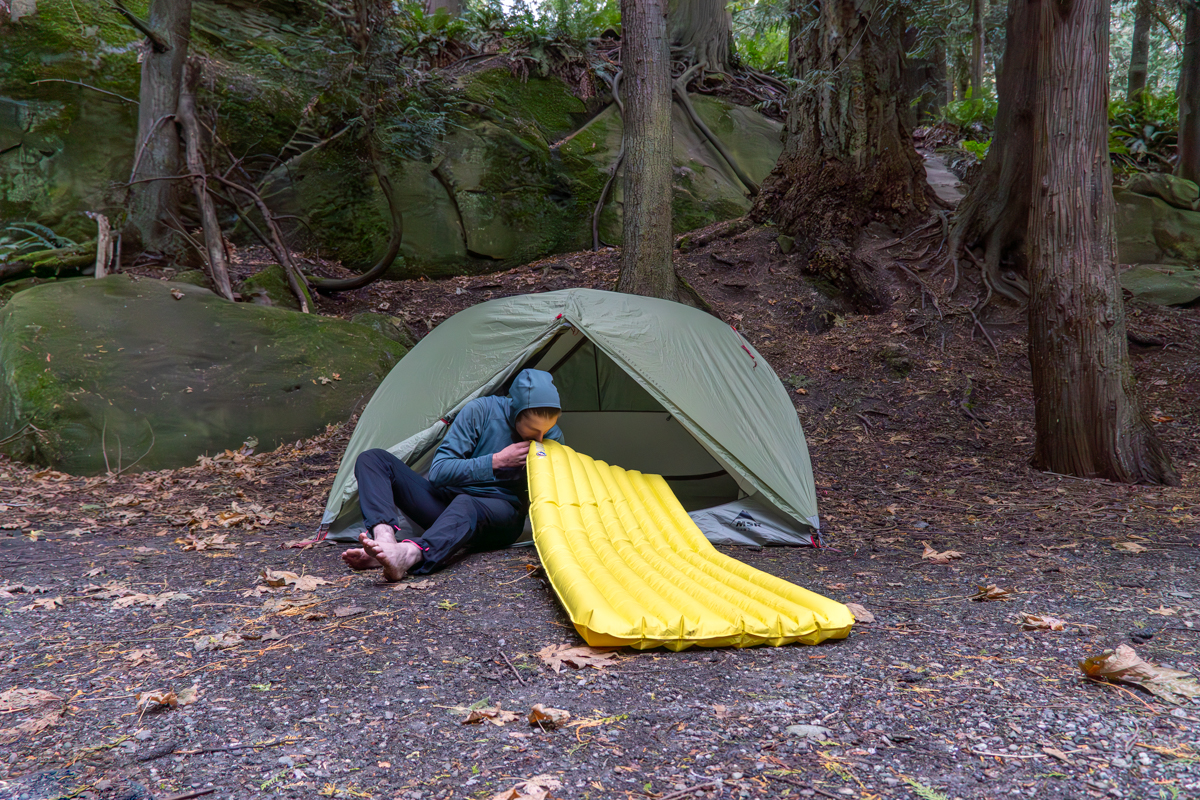
 Category: Air pad
Category: Air pad
Weight: 1 lb. 1.3 oz.
Thickness: 4 in.
R-value: 3.2
What we like: Excellent comfort and isolation from the ground with a super-thick build.
What we don’t: Expensive and only moderately insulated.
For side sleepers and those who move around a lot during the night, Sea to Summit’s Ether Light XT Insulated is the ticket. With a whopping 4 inches of cushioning off the ground, the Ether is the thickest sleeping pad on this list while weighing in at a respectable 1 pound 1.3 ounces. Other notable features include Sea to Summit’s distinctive Air Sprung Cells, a 3.2 R-value that should suffice for most summer and shoulder-season backpacking trips (it worked for us on nights in the mid-20s Fahrenheit), and a dual pump/stuff sack for quick and painless inflation. Taken together, the Ether is one of the most luxurious pads on the market.
Admittedly, such a thick pad is unnecessary for many backpackers, including those who tend to sleep on their back and smaller humans in general (we’ve found that 2.5-in. pads are sufficient in most instances). In addition, the extra cushioning that the Sea to Summit offers comes with a bump in weight—the Ether Light XT Insulated is over 5 ounces heavier than the XLite above. Further, if weight isn't a major concern, it's also worth checking out Nemo’s premium Quasar 3D below, which features a soft-touch top, rectangular shape, and slightly higher R-value of 3.5. But all in all, for side sleepers looking to put as much space as possible between their body and the ground, the Ether is hard to beat. Sea to Summit also offers the Ether Light XT Extreme ($229; 1 lb. 9.4 oz.), which adds Thermolite insulation to achieve an R-value of 6.2, as well as the lighter, summer-focused Ether Light XT Air ($179; 13.8 oz.). And, if weight isn't too much of a concern, check out the thicker Therm-a-Rest NeoLoft below—a true dream for side sleepers.
See the Sea to Summit Ether Light XT Insulated

 Category: Air Pad
Category: Air Pad
Weight: 1 lb. 13.8 oz.
Thickness: 3 in.
R-value: 2.9
What we like: Thoughtful design with separate air chambers for each person; light weight for two pads in one; raised baffles on perimeter.
What we don’t: Not the warmest or most durable out there; takes a while to inflate by mouth (but pump sack works great).
If you're already sharing the weight of a two-person tent, you might as well share a sleeping pad as well. For those hiking in a pair, two-person sleeping pads are game changers for sleep system efficiency, and allow you to bring your kit and base weight down even more. Plus, for couples who like to cuddle close at night, trying to do that with two separate slippery pads will immediately highlight the value of something like Exped's cozy Ultra 3R Duo. With a 41.3-inch width at the head, and 32.3-inch width at the feet, it's slim enough to cut bulk and weight, while comfortably accommodating two hikers. Our editor and his partner regularly share this pad on long treks, and his partner is 6'2".
We love the independent air chambers on the 3R Duo, which allow each sleeper to customize the air pressure on their side of the pad without impacting the other person—a cherished feature if your partner is a side sleeper and you are not. The downside to this is four valves to manage, which adds weight and can be a frustration when deflating and rolling up. The location of the valves also makes fully deflating the pad a bit of a chore. Additionally, with an R-value of 2.9, this isn't the warmest pad out there, and is best suited for summer or warmer shoulder-season pursuits. Finally, we have some durability concerns with the 20-denier fabric—this minimizes weight and bulk, but is on the thinner end of the spectrum. All told, the Ultra 3R Duo is a fantastic choice for couples who frequently trek together, but warmth and durability are sacrificed to pave the way for such a low weight and small packed size.
See the Exped Ultra 3R Duo

 Category: Air pad
Category: Air pad
Weight: 15.5 oz.
Thickness: 3 in.
R-value: 7.3
What we like: High R-value for below-freezing conditions; new, quieter design.
What we don’t: Pricey and overkill for most backpackers.
For high-altitude climbers, winter campers, or those who experience sub-freezing temps on their backpacking trips, Therm-a-Rest’s NeoAir XTherm NXT is worth a serious look. This pad has a similar design to the brand’s popular XLite above but adds more layers of ThermaCapture, which mimics a built-in emergency blanket by reflecting back your body heat. The result is a winter-ready R-value of 7.3 for just 15.5 ounces, which is truly an impressive feat. And like the XLite above, the XTherm NXT features new technology that delivers a quieter sleep than the outgoing version. If you’re on the hunt for a premium 4-season pad, it's hard to beat this streamlined design.
Price is the biggest hurdle for most backpackers, with the Therm-a-Rest XTherm starting at a steep $240 for the regular size (the large is even more at $270). Further, the high R-value is overkill for most 3-season trips, which constitutes the majority of backpackers. But on the other hand, the XTherm is still lighter and more packable than the vast majority of sleeping pads here, and significantly more hardwearing with its thick 70-denier bottom. If you need the extra warmth or durability and can afford it, the XTherm NXT is an exceptional cold-weather standout for serious adventurers. As another stellar 4-season opetion, we've had great luck with the competitively-specced Nemo Tensor Extreme Conditions.
See the Therm-a-Rest NeoAir XTherm NXT
 Category: Closed-cell foam
Category: Closed-cell foam
Weight: 14.5 oz.
Thickness: 0.9 in.
R-value: 2.0
What we like: Cheap and will never pop; thicker than the Therm-a-Rest Z Lite.
What we don’t: Not nearly as comfortable as inflatable sleeping pads.
We’ll start by saying that the Switchback from Nemo is not the right choice for those looking for a cushy and comfortable sleeping pad. You get a little less than an inch of closed-cell foam, along with a reflective coating designed to capture radiant heat. But we love this pad for two very important reasons: It's cheap at just $60 for the regular version, and it will never pop. Despite the very thin and simplistic nature of foam, we’ll take the Switchback over a $150+ air pad with a hole any day. Plus, it’s incredibly versatile: Use it as a seat around camp, sub it in for your pack’s foam backpanel to save weight, or slide it under your air or self-inflating pad for additional warmth or protection. Heck, we even use our foam pad to keep dinner or water warm (wrapping it around the pot) in our camp kitchen.
Compared to the uber-popular and longstanding Therm-a-Rest Z Lite Sol below, the Switchback wins out in most ways. For the same price, the Nemo is thicker (0.9 in. compared to 0.75 in.) yet packs down to the same size. We also think it’s a touch more comfortable, although it's a close call between the two. All that said, you’ll still feel rocks and roots beneath you much more than with the pricier air options above and below, and with an R-value of just 2 it won’t keep you insulated from the cold ground outside of the summer months. But as a versatile add-on or a dedicated UL pad that won’t pop, the Switchback is a great piece of gear to add to your kit. For a cheaper solution, Exped now offers their FlexMat ($40), but it doesn’t pack up as small as the Switchback and Z Lite, and its thinner construction (0.7 in.) means less insulation overall (the Exped’s R-value is 1.5).
See the Nemo Switchback

 Category: Air pad
Category: Air pad
Weight: 1 lb. 8.9 oz.
Thickness: 4.6 in.
R-value: 4.7
What we like: Impressively light for the thickness, warm R-value, cozy stretch knit face fabric.
What we don’t: Heavy and bulky; takes up a lot of tent real-estate.
No... you didn't just accidently hop over to our best camping mattresses round-up. Despite its beautifully plush appearance, the NeoLoft is indeed a backpacking sleeping pad, with competitive specs that challenge models with half the thickness and less insulation. A true testament that innovation in the backpacking world still exists. Boasting a whopping 4.6-inch thicknes (the highest on this list), and a toasty 4.7 R-value—all in an impressive 1 lb. 8.9 oz. package (regular)—this work of art is a boon for those seeking the utomost comfort in a backpacking-ready design. It's also a dream come true for chronic slide sleepers, if you're willing to carry a bit more weight than the Ether Light XT above. The true headliner for us, however, is the plush stretch knit face fabric. If you're sick of the classic crinkly nylon feel of essentially every other pad out there—you're in luck. The knit fabric is quiet, soft, and seems to lull you to sleep. You just can't find this on other pads billed for the backcountry.
This cozy material also has multidirectional elasticity, boosting contouring support and helping to minimize pressure points. Coupled with large side-rail chambers, the pad seems to hold you snugly in the center without feeling constricting. Packing so much tech and comfort into a streamlined design is admittedly difficult, so our cons are pretty obvious. The NeoLoft definitely has one of the larger packed sizes of any backpacking pad we own, and is a good deal heavier than pads with higher R-values, like the 1 lb. 6 oz. Exped Ultra 7R (R-value: 7.1) or the 15.5 oz. Therm-a-Rest NeoAir XTherm NXT (R-value: 7.3). That said, it has a comparable weight to pads like the 1 lb. 8.5 oz. Rab Stratosphere 4, which only has an R-value of 3.8. In the end, if you're willing to schlep some extra weight and bulk, the comfort this pad offers is next-to-none. As the thickest pad on this list, it's our go-to for shorter backpacking trips where we can afford some luxury items, or as a remote basecamp bed on longer expeditions.
See the Therm-a-Rest NeoLoft Sleeping Pad

 Category: Air pad
Category: Air pad
Weight: 1 lb. 6 oz.
Thickness: 2.5 in.
R-value: 3.7
What we like: Warmer and more plush than the Ether Light XT above.
What we don’t: Heavier than the leading Therm-a-Rest pads.
Sea to Summit’s Ether Light XT Insulated above is our favorite pick for side sleepers, but for a solid all-rounder, it’s worth checking out their Comfort Light Insulated here. In contrast to the horizontal or vertical baffles of most air pads, both Sea to Summit models have an innovative cell design (dubbed Air Sprung Cell technology) that maximizes surface area connecting the pad to your body, resulting in better support and weight distribution throughout. Importantly, the Comfort Light Insulated tacks on a second layer of cells at the torso, increasing warmth and comfort where you need it while minimizing weight and bulk everywhere else. And like the Ether Light XT, the Comfort Light features a wider shape than most designs (21.5 vs. the standard 20 in.) and relatively durable face fabric (30D and 40D).
When deciding between the Comfort Light and the Ether Light XT above, there are a few things to keep in mind. As we mentioned, the Ether Light XT’s 4-inch loft is ideal for keeping side sleepers off the ground, and the pad is lighter by over 4.5 ounces (which also translates to less bulk). On the other hand, the Comfort Light here is a bit warmer despite its thinner design—particularly from the hips up—and offers a plusher feel than the slightly more rigid Ether (especially for back sleepers). Neither pad can match the warmth-to-weight ratio of the Therm-a-Rest or Nemo above, but the added comfort of the Air Sprung Cells will be well worth it for some. Finally, you can bump up to the celebrated Comfort Plus Insulated Air for a warmer design (R-value: 4), but in our opinion, it’s not worth the extra 7 ounces and $40.
See the Sea to Summit Comfort Light Insulated See the Women's Comfort Light Insulated
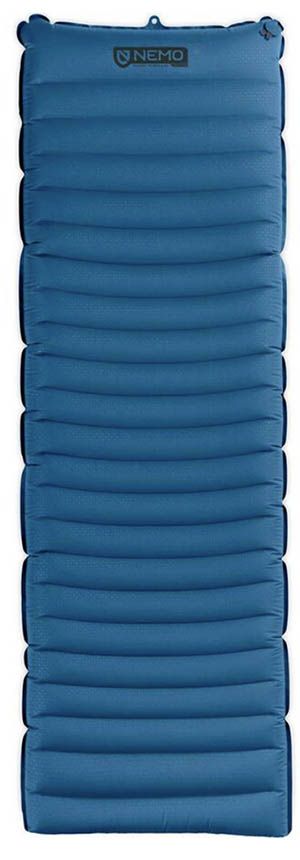 Category: Air pad
Category: Air pad
Weight: 1 lb. 9 oz.
Thickness: 3.5 in.
R-value: 3.3
What we like: A comfort-first pad for backpacking, camping, and more.
What we don’t: Heavier than most air pads here.
It might be called a “backpacking” sleeping pad, but let’s face it: A lot of us use our mats for more than just nights on the trail, whether it’s bedding down in a vehicle, at a frontcountry campground or on a friend’s living room floor. For a pad that can do it all, check out Nemo’s Quasar 3D. Marketed as a “quiver killer,” the Quasar combines a decently lightweight build with a roomy rectangular shape (no mummy option) and impressive comfort. Soft contours hug your body and keep you centered on the pad, and you get 3.5 inches of cushioning (great for side sleepers) and an elevated baffle at one end to prop up your head or keep your pillow in place. Added up, the Quasar toes the line between a camping mattress and backpacking pad better than most—enough so that it's featured in both articles.
But as with the majority of gear that seeks to be the jack of all trades, the Quasar 3D is master of none. At 1 pound 9 ounces for the insulated design (3.3 R-value), it has one of the poorest warmth-to-weight ratios of any air pad here. And while $160 is a fairly competitive price point, you can save $40 with the Big Agnes Divide Insulated, which is both lighter and warmer. But if comfort is the main factor in your equation, it’s true that the Quasar 3D is a cut above most backpacking pads. Finally, Nemo also offers a non-insulated version (R-value: 1.8) for $140; both Quasar models are bluesign-certified and made with 100%-recycled materials.
See the Nemo Quasar 3D Insulated
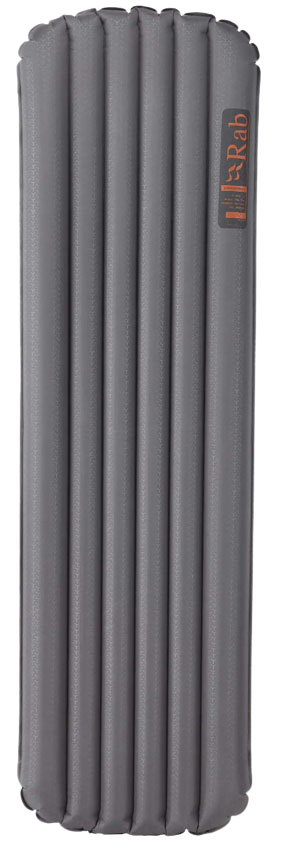 Category: Air pad
Category: Air pad
Weight: 1 lb. 8.5 oz.
Thickness: 3.1 in.
R-value: 3.8
What we like: A durable pad for a great price.
What we don’t: Heavy; unreliable valve design.
Rab Equipment is known for their alpine-ready outerwear, which offers no-frills performance at a reasonable price. The U.K.-based brand only recently dipped into the world of sleeping pads, and their collection includes the self-inflating Exosphere, high-tech Ionosphere, and mid-range Stratosphere here. We tested the Ionosphere 5 and the Stratosphere 4 on a recent trip to Patagonia, and while we were disappointed with the slippery and overly streamlined nature of the former, we came away with slightly more promising impressions of the latter. For both pads, the highlight was the large, elasticized opening on the stuff sack, which is the best design we’ve seen yet.
The Stratosphere's main selling point is its 75-denier material, which makes the pad significantly more hardwearing than most. If you're hard on your gear or like to sleep outside of a tent, finding a thicker design like the Rab here is a great idea. We also appreciated the Stratosphere's roomy rectangular shape and oversized outer baffles, which kept us centered on the pad (this was especially relieving after sleeping on the Ionosphere 5 the night before, which seemed to want to spit us off with each movement). But we were very disappointed with the Stratosphere's valve, which easily popped out of the pad when we removed the pump sack. The warmth-to-weight ratio is nothing to write home about, either. Added up, we see a lot of room for improvement in Rab’s offerings, but if you want a pad to use and abuse and don’t mind schlepping the added ounces, the Stratosphere 4 will get the job done.
See the Rab Stratosphere 4
 Category: Closed-cell foam
Category: Closed-cell foam
Weight: 14 oz.
Thickness: 0.75 in.
R-value: 2.0
What we like: Durable and lightweight.
What we don’t: The Nemo Switchback above is thicker and more comfortable.
Therm-a-Rest’s Z Lite Sol is a backpacking classic. This basic 3/4-inch pad features tough closed-cell foam, a reflective coating for a boost in warmth, and a budget-friendly price of $58. Further, the pad folds up accordion-style into a reasonably compact package for storing on the top, side, or bottom of a pack. As with the Nemo Switchback above, the Z Lite is not a leader in terms of comfort, but it’s hard to argue with the dependability of a cheap foam mat.
You’ll see the Therm-a-Rest Z Lite Sol strapped to a surprisingly high number of packs. Ultralighters love the low weight and dependability, budget backpackers love the price, and winter campers use it as a second mat for a boost in warmth. In the end, the Switchback above beats it in comfort with its thicker, more plush design, but the Z Lite is the proven choice that still gets the slight edge in weight (14 oz. vs. 14.5 for the Nemo).
See the Therm-a-Rest Z Lite Sol
 Category: Self-inflating/air pad
Category: Self-inflating/air pad
Weight: 1 lb. 7 oz.
Thickness: 2 in.
R-value: 3.3
What we like: The thickness of an air pad and the reliability of a self-inflating model.
What we don’t: Thin, 20-denier shell and large packed size.
Nemo’s Flyer is in a category of its own as a hybrid air/self-inflating pad that brings together the best features of both styles. To create the Flyer, Nemo took the design of a self-inflating pad, trimmed down the amount of open-cell foam by 60%, and added insulation and comfort via air-filled baffles. The net result is a mat that’s reasonably light at 1 pound 7 ounces, easy to set up (it's self-inflating), and decently compressible with a stuffed size of 6.5 by 10 inches. And importantly, the Flyer retains the supportive, plush cushioning of a self-inflating pad, which keeps you insulated from the ground even in the event of a leak.
Nemo recently updated the Flyer with bluesign-approved materials (the fabrics are now 100% recycled), but the design remains the same. With a 20-denier shell, the pad is similarly vulnerable to punctures as the brand’s much lighter Tensor, although (as we mentioned above) you’ll at least have a little foam cushioning with the Flyer to keep you protected if the pad gets a hole. If you prefer a self-inflating build but want to keep things light and compact, we think the Flyer is well worth checking out.
See the Nemo Flyer
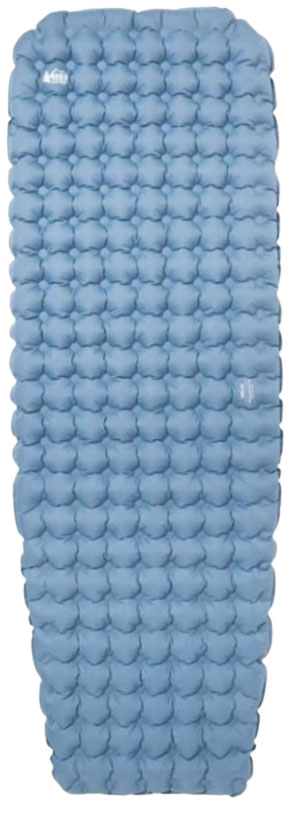 Category: Air pad
Category: Air pad
Weight: 1 lb. 5 oz.
Thickness: 3 in.
R-value: 4.9
What we like: Comfort-first design and inclusive pricing/sizing.
What we don’t: More expensive than the similarly spec’d Big Agnes Divide Insulated above.
REI’s $100 Flash used to be one of our favorite budget pads, but their new Helix takes aim at a different market with a warmer, more insulated design (R-value: 4.9). Like the old Flash, the Helix’s gridded baffle pattern mimics designs from Sea to Summit, providing arguably better weight distribution and comfort compared to pads with horizontal or vertical baffles. It also features a thoughtful shape that maximizes the 20-inch width throughout, narrow just above the foot to slot nicely into tapered tents. And the rest of the pad is competitive with most modern offerings, including layers of reflective insulation that provide warmth without bulk and easy-to-use inflation and deflation valves.
What stands out to us most about REI’s new Helix Insulated is the standardized price tag—for $169, you can get a regular, regular wide, or long wide size. This is part of REI’s push towards inclusive sizing, and we appreciate the effort (with most pads, you’ll spend up for longer or wider models). At this price point, it slides into a nice middle ground on our list, offering more comfort than a budget pad like the Big Agnes Divide Insulated ($120) and more warmth for the weight than a pricier offering like the Sea to Summit Comfort Light Insulated. We’ve used REI’s air pads in the past with varying results (initial designs suffered in terms of durability, but their quality has improved over time), but all signs point to the Helix Insulated being one of their best efforts yet.
See the REI Co-op Helix Insulated
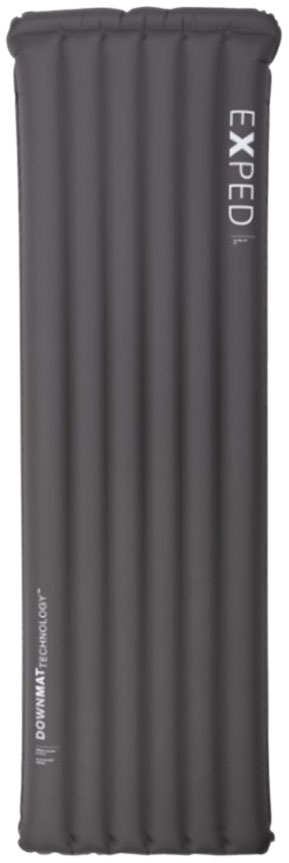 Category: Air pad
Category: Air pad
Weight: 1 lb. 6 oz.
Thickness: 3.5 in.
R-value: 7.1
What we like: One of the highest R-value backpacking pads on the market.
What we don’t: Significantly tapered, relatively fragile, and overkill for most conditions.
Most of the sleeping pads on the list are built for 3-season conditions with varying levels of insulation. But for the highest R-value of any backpacking pad here, the new Exped Ultra 7R takes the cake at 7.1. With a unique design that uses 700-fill goose down as insulation, the Ultra 7R also is a substantial 3.5 inches thick and quite comfortable to sleep on. You can't inflate this pad manually, as the moisture from your breath can damage the down fill, but the included waterproof compression sack doubles as a fully functional pump bag. For 4-season backpacking, basecamping, and as an expedition mat, the Exped wins out in warmth.
The newest Ultra 7R improves upon Exped’s old DownMat XP 9, with a much lower weight and only small concessions in terms of warmth. However, the Ultra 7R’s 20-denier recycled ripstop polyester is noticeably more fragile (the DownMat used 75D), and the mummy-version of the pad also features a significant taper from the shoulders to the toes. Compared to the uber-popular Therm-a-Rest XTherm above, the Ultra 7R is slightly warmer and a full inch thicker, but the trade-off comes in terms of weight and durability: The XTherm is 6 ounces lighter and has a 70-denier base. In the end, the Therm-a-Rest is a more well-rounded and time-tested offering, but the Exped isn’t far behind and is certainly deserving of a spot on our list.
See the Exped Ultra 7R
 Category: Air pad
Category: Air pad
Weight: 14 oz.
Thickness: 3.5 in.
R-value: 4.3
What we like: Solid comfort for less than the competition.
What we don’t: Doesn't live up to its 4.3 R-value; basic two-way valve slows down deflation.
New to the scene is the Big Agnes Zoom UL, the lightest pad in their lineup and—on paper at least—worthy competition to the likes of the Therm-a-Rest NeoAir XLite NXT and Nemo Tensor All-Season above. The Zoom UL slots in between the two headlining pads in terms of weight but goes above and beyond with a roomier rectangular build and supportive O-beam construction that’s similar to that of our top comfort pick, the Sea to Summit Ether Light XT Insulated. You also get a generous 3.5 inches of cushion, which is identical to the Tensor and 0.5 inches thicker than the NeoAir XLite. And at $180, it undercuts the aforementioned pads by a significant $20 to $30.
In our opinion, it’s clear that Big Agnes did everything possible to make the Zoom UL’s specs look as good as possible, but to the pad’s detriment. Take the packed size, for example: It’s impressively small, but you’ll have to do a lot of wrangling to get the pad back into its stuff sack after removing it for the first time. Second, the two-way valve is basic, and unlike more modern designs, you’ll have to push the air out when it’s time to deflate. But our primary gripe is the Zoom UL’s warmth: The pad simply does not live up to its 4.3 R-value. We took it backpacking in the heart of the summer and suffered two very cold nights, and we’ve heard similar reports from others. Overall, the Zoom UL fell well short of our expectations, but if you’re looking for lightweight comfort and plan to use the pad in very mild conditions, it’s still a worthy contender.
See the Big Agnes Zoom UL
 Category: Air pad
Category: Air pad
Weight: 1 lb. 3.6 oz.
Thickness: 2.5 in.
R-value: 4.4
What we like: Wide sleeping platform and great price.
What we don’t: Not a standout in any specific category.
Klymit’s radical X Frame pad may have put the company on the map, but their follow-up Insulated Static V Lite is their best offering. Whereas the X Frame cuts away excess materials and resembles a skeleton (and offers no insulation from the ground), the Static V Lite is a little more traditional and comfortable. We particularly like the 23-inch width (most regular pads are 20 in. wide). Combined with raised baffles along the sides, the Klymit is a stable and roomy sleeping platform that is great for active sleepers. And priced at just $110, it’s a great value, too.
Outside of the extra space and very competitive price, however, the Insulated Static V Lite doesn’t really stand out. Using 30-denier fabric, we’d expect it to weigh less than 1 pound 3.6 ounces (the warmer 1-lb. XTherm has 70D material on its bottom), so you sacrifice durability without the typical reward of weight. Its V-like baffles also can’t match the sleeping comfort of the premium options above from Sea to Summit, Therm-a-Rest, Big Agnes, and Nemo, which drops the Klymit to the very bottom of our list. For an even cheaper pad, check out the uninsulated Static V (R-value: 1.3).
See the Klymit Insulated Static V Lite
| Sleeping Pad | Price | Category | Weight | Thick | R-Value | Denier | Packed |
|---|---|---|---|---|---|---|---|
| Therm-a-Rest NeoAir XLite NXT | $210 | Air pad | 13 oz. | 3 in. | 4.5 | 30D | 4.1 x 9 in. |
| Nemo Tensor All-Season UL | $200 | Air pad | 14.1 oz. | 3.5 in. | 5.4 | 20D/40D | 4 x 10 in. |
| Big Agnes Divide Insulated | $120 | Air pad | 1 lb. 6 oz. | 3.25 in. | 4.0 | Unavail. | 4 x 7.5 in. |
| Sea to Summit Ether Light XT | $199 | Air pad | 1 lb. 1.3 oz. | 4 in. | 3.2 | 30Dx40D | 4.5 x 9.5 in. |
| Exped Ultra 3R Duo | $250 | Air pad | 1 lb. 13.8 oz. | 3.5 in. | 2.9 | 20D | 9.8 x 5.5 in |
| Therm-a-Rest XTherm NXT | $240 | Air pad | 15.5 oz. | 3 in. | 7.3 | 70D | 4.5 x 9 in. |
| Nemo Switchback | $60 | Foam | 14.5 oz. | 0.9 in. | 2.0 | N/A | 5 x 20 in. |
| Therm-a-Rest NeoLoft | $240 | Air pad | 1 lb. 8.9 oz. | 4.6 in. | 4.7 | 50Dx75D | 9.5 x 5.7 in. |
| Sea to Summit Comfort Light | $199 | Air pad | 1 lb. 6 oz. | 2.5 in. | 3.7 | 30Dx40D | 4.5 x 9.5 in. |
| Nemo Quasar 3D Insulated | $160 | Air pad | 1 lb. 9 oz. | 3.5 in. | 3.3 | 30D | 4.5 x 8 in. |
| Rab Stratosphere 4 | $140 | Air pad | 1 lb. 8.5 oz. | 3.1 in. | 3.8 | 75D | Unavailable |
| Therm-a-Rest Z Lite Sol | $60 | Foam | 14 oz. | 0.75 in. | 2.0 | N/A | 5.5 x 20 in. |
| Nemo Flyer | $140 | Self-inflating/air | 1 lb. 7 oz. | 2 in. | 3.3 | 20D | 6.5 x 10 in. |
| REI Co-op Helix Insulated | $169 | Air pad | 1 lb. 5 oz. | 3 in. | 4.9 | Unavail. | 5 x 9.5 in. |
| Exped Ultra 7R | $220 | Air pad | 1 lb. 6 oz. | 3.5 in. | 7.1 | 20D | 5.5 x 11 in. |
| Big Agnes Zoom UL | $180 | Air pad | 14 oz. | 3.5 in. | 4.3 | Unavail. | 4 x 8 in. |
| Klymit Insulated Static V Lite | $110 | Air pad | 1 lb. 3.6 oz. | 2.5 in. | 4.4 | 30D | 5 x 8 in. |
Popped sleeping pads, torn tents, broken zippers—the editors at Switchback Travel have seen it all in the backcountry. As a result, we put a premium on quality, well-built designs, especially when they can potentially impact our sleep. Founder and globetrotter David Wilkinson started this list in 2016 with just 10 sleeping pads—including past versions of the Therm-a-Rest NeoAir and Sea to Summit Comfort, both of which are still featured above. Former editors John Ellings and Jenny Abegg, both based in eastern Washington, began contributing soon after. John and Jenny both spend as much time as possible in the backcountry—whether on bikes, on skis, or by foot. Senior editor Chris Carter now manages this round-up, and as a lifelong backpacker and alumnus of each of the Triple Crown trails (AT, PCT, and CDT), he has his systems dialed in to maximize comfort while minimizing weight.
Our current lineup of 17 sleeping pads reflects the variability in the market: Casual backpackers may be willing to deal with a little added heft and bulk for the boost in comfort on short weekend trips, in which case a self-inflating pad makes a lot of sense. On the other hand, thru-hikers spending months on the trail are typically willing to make considerable sacrifices to keep their base weight as low as possible, often opting for basic foam pads that won’t pop and can serve a number of purposes (e.g., as a camp seat or additional insulation in the cold). That said, while individual needs may vary, all of the pads above stand out in one way or another—and many impressed us in multiple categories during testing. As the market changes and we gain experience with new and noteworthy designs, keep an eye out for updates to the list above.

Air Pads
Backpacking sleeping pads fall into three general categories: air, self-inflating, and closed-cell foam. Air pads offer unmatched compactness, often rolling down to the same size as a Nalgene bottle. They’re also the lightest option while at the same time providing unmatched thickness. Bonded insulation or baffling techniques can bring impressive warmth, highlighted by the Therm-a-Rest XTherm NXT (R-value: 7.3). The primary downside is a greater puncture risk, and it’s a big consideration. Middle-of-the-night deflations can ruin a trip really fast. Bringing along a patch kit should alleviate most concerns, but it’s still the biggest reason not to buy an air pad.

Self-Inflating Mats
The self-inflating mattress was a revolutionary idea when the Therm-a-Rest was invented in 1972. By combining open-cell foam and a space for the pad to expand and fill with air, it brought convenience, decent durability, and comfort. It’s a testament to that technology that most of today’s self-inflating pads haven’t deviated much. Compared with air pads, self-inflating options are more puncture-resistant, and you still have some semblance of padding if it deflates in the middle of the night. Negatives are that the foam brings extra poundage and they don’t pack down as small as an equivalent air pad. Backpacking options are also often not as thick (exceptions include Sea to Summit's SI line), leading to complaints from side sleepers.
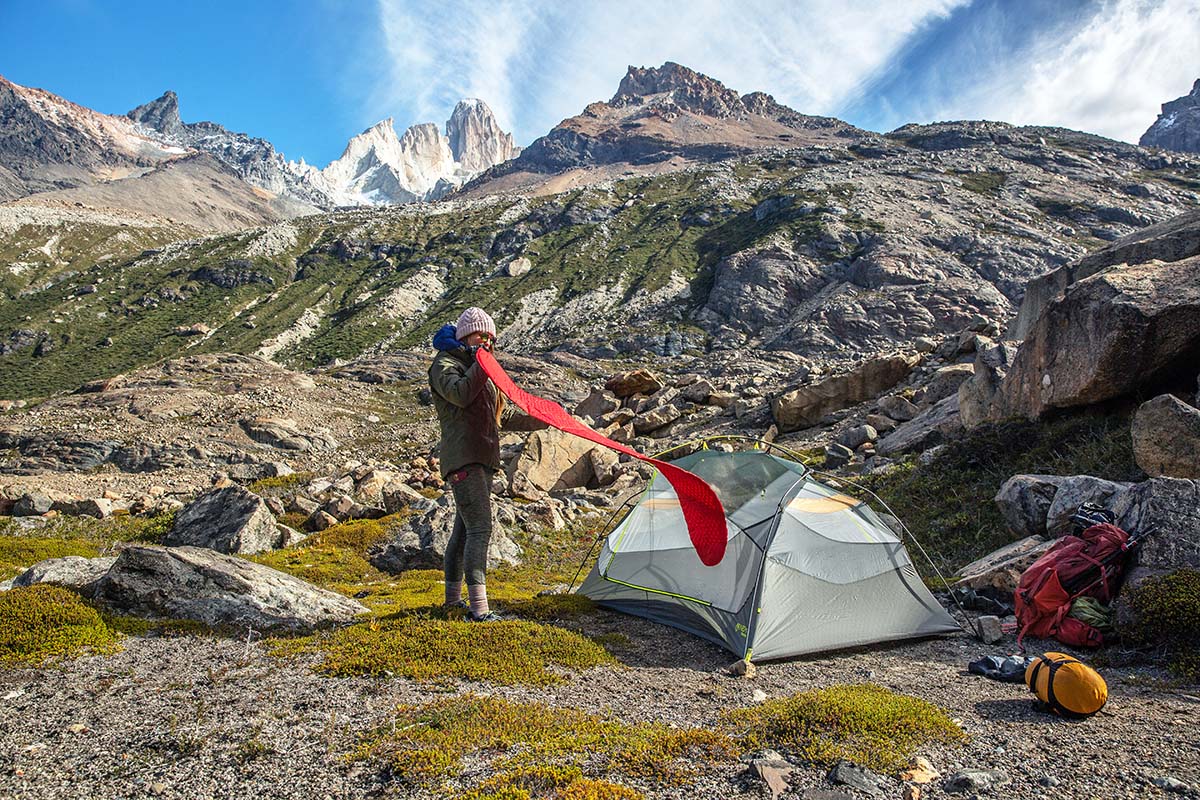
Foam Pads
The old closed-cell foam pads still have a place on this list as a dependable, tried-and-true option. Yes, they’re the least comfortable option, don’t pack as small, and don’t have the highest R-values, but they also have exactly a zero percent chance of deflating in the middle of the night. And they’re the perfect secondary pads to bring along for winter camping. Designs like the Therm-a-Rest Z Lite Sol and Nemo Switchback are staples for long-distance trekkers and thru-hikers due to their versatile and lightweight constructions.

Two-person backpacking sleeping pads afford the opportunity for couples or partners who often trek together to save weight and space and improve overall sleep comfort. While they are too bulky and heavy for individual backpackers, if you are already sharing the weight of your tent, cook kit, and other categories in your pack, it makes sense to share a sleeping pad as well. Have one person carry a heavier pot or stove while the other totes a pad for two. You'll be surprised at how much space you can conserve.
Pads like Exped's Ultra 3R Duo (our favorite two-person pad for backpacking) strike a healthy balance between comfort, bulk, and weight. At 1 lb. 13.8 oz., it is lighter than carrying two single-person pads like the 1 lb. 1.3 oz. Sea to Summit Ether Light XT, and simplifies the setup process when it's time for bed. The downside to this sleep system is that you can't separate mid-journey and go off on your own. While this isn't a big concern on shorter weekend or week-long trips, those embarking on long thru-hikes or multi-month excursions will want to be as self-sufficient as possible.

Weight is a primary consideration for many backpackers—just look at the quick rise of the ultralight backpacking movement. On this list, you’ll find everything from the 13-ounce Therm-a-Rest NeoAir XLite NXT to the 1-pound-9-ounce Nemo Quasar 3D Insulated. We think that the best backpacking pad options are in the 12- to 18-ounce range, offering cutting-edge materials along with respectable levels of comfort and warmth. Keep in mind, as with any piece of outdoor gear, the less it weighs, the more fragile it will be. It doesn’t make a ton of sense to buy a $200 ultralight sleeping pad if you only plan on using it on a couple of easy weekend trips each summer. And regardless of its weight, make sure to take reasonable care when setting up camp and stowing your pad (more on this in the sleeping pad care section below). If you'd like to focus your search on lighter options that appear in this review, check out our dedicated round-up of the best ultralight sleeping pads.

Comfort is relative when sleeping on the ground, and most people who can’t handle a night under the stars don’t backpack or camp at all. Backpacking pads are thinner and less plush than camping mattresses and pads, but the latest outdoor gear technology has made advances in this department. We think Sea to Summit’s Air Sprung Cells (2 in. thick on their Ultralight Insulated, 2.5 in. on their Comfort Light, and 4 in. on their Ether Light XT Insulated) make for some of the most comfortable lightweight sleeping pads around, although they can’t quite compete with Therm-a-Rest in terms of weight and R-value per ounce. For a noticeable boost in comfort and stack height, Therm-a-Rest's plush NeoLoft boasts a groundbreaking 4.6-inch thickness, with a supremely soft and quiet stretch knit face fabric to boot. It's heavier and bulkier than most backpacking pads out there, but a dream come true for backcountry comfort in a packable design.
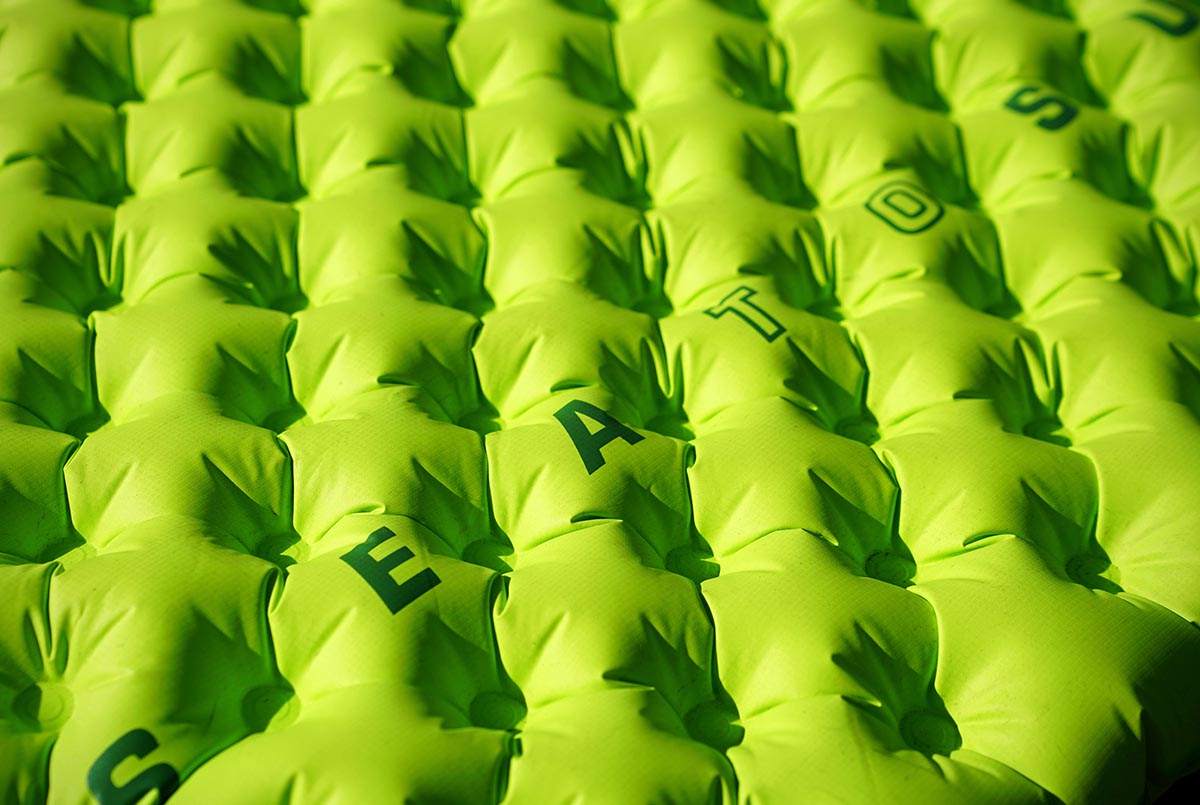
You may notice a lot of chatter in product comments about being a back sleeper or a side sleeper. Back sleeping more evenly distributes your weight, whereas side sleeping puts a higher percentage of weight around the hips and shoulders. If you are a side sleeper or don’t sleep particularly well in the outdoors, check out a substantial pad like the Sea to Summit Ether Light XT Insulated (4 in. thick). If you need serious cushion, consider one of the lighter options on our list of the best camping mattresses and pads.
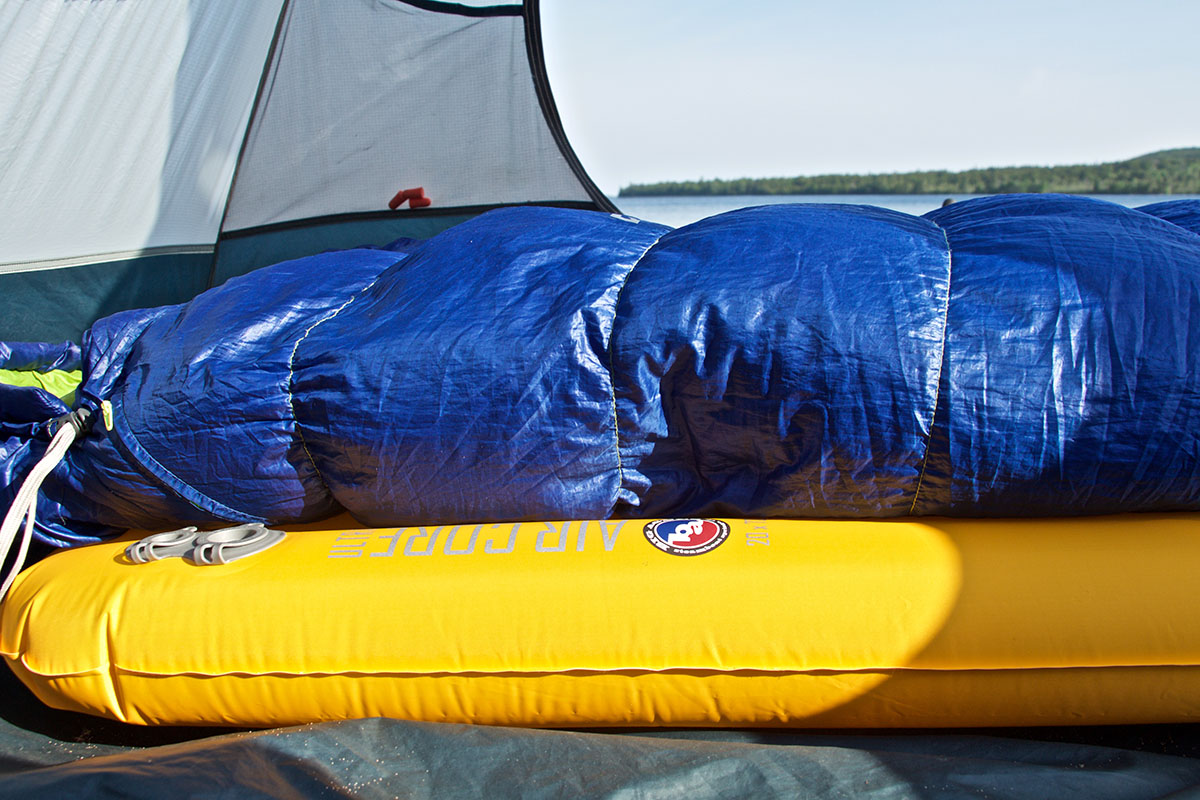
Baffle Design
While on the topic of comfort, it’s important to note that baffle design can have a pretty considerable impact, too. In general, we’ve found that vertical baffles—like those found on Big Agnes’ Divide Insulated—tend to be less supportive and comfortable than horizontal or boxed. On the flip side, we really like Sea to Summit’s Air Sprung Cells found on their Ether Light XT and Comfort Light pads above, which have a decidedly plush and nicely padded feel. Another standout is Nemo’s Quasar 3D, which boasts a raised baffle at the head end for keeping your head and/or pillow elevated. To be fair, baffle shape and layout are largely a matter of personal preference, and there are certainly some quality vertical designs on the market. But on the whole, we’ve found they feel a little less natural and fall short in both comfort and stability.

A critical spec in comparing sleeping pads is R-value, or how much insulation a pad provides from the ground. Don’t underestimate R-value: Using an uninsulated or too lightly insulated pad, even in cool temperatures, can make you quite cold throughout the night. And even a warm and thick sleeping bag won’t save you because your body compresses the insulation along the bottom of the bag, thereby letting cold air up and compromising its ability to keep you warm. To prevent this from happening, you’ll need a sleeping pad that offers an appropriate level of protection from the cold ground.

In terms of recommended ranges, summer-only backpackers who stick to warm conditions can get away with an R-value of 3 or less. Most 3-season backpackers should get a sleeping pad with an R-value in the range of 3 to 5, and this where a majority of our picks above are rated. Last but not least, winter camping requires an R-value that exceeds 5, with the most popular models being the Therm-a-Rest NeoAir XTherm (R-value: 7.3) and Nemo Tensor Extreme Conditions (8.5 R-value). If you will be camping on snow, it’s a good idea to bring a combination of pads, especially if one is of the inflatable variety (imagine waking up in the middle of the night on top of snow on essentially a deflated balloon). For this reason, many winter campers bring along a closed-cell foam model like the Nemo Switchback or Z Lite Sol to be safe. For a deeper dive into this topic in general, see our article on Sleeping Pad R-Value Explained.
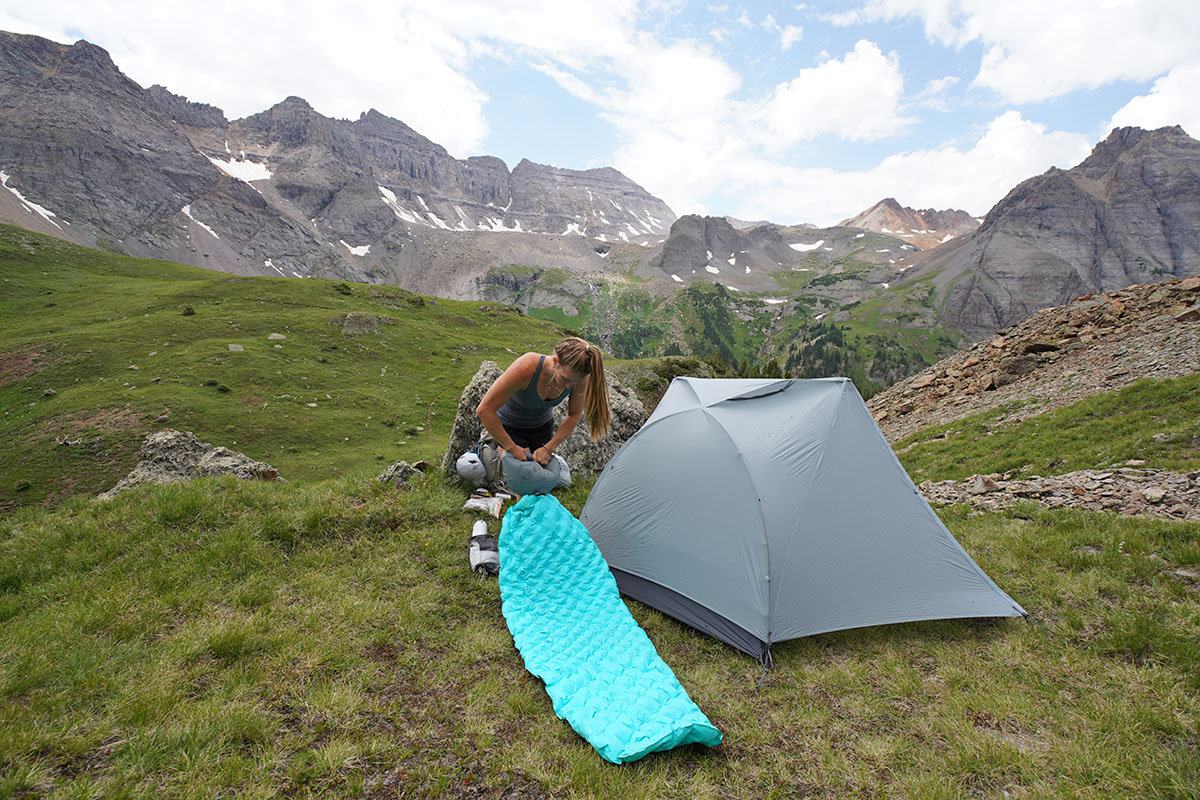
Recommended sleeping pad R-values:
The ASTM Standard
All current sleeping pads above are now rated based on a standardized ASTM International test. In this process, pads are sandwiched between a hot plate (35˚ Celsius) on top, which mimics the body, and a cold plate (5˚ Celsius) underneath, mimicking the ground. Over the course of four hours, testers measure how much energy the top plate uses in order to stay at a consistent 35 degrees Celsius. The less energy it takes, the more insulative the pad. The more energy it takes, the less insulative the pad. The net result is more accurate and dependable ratings across the board.
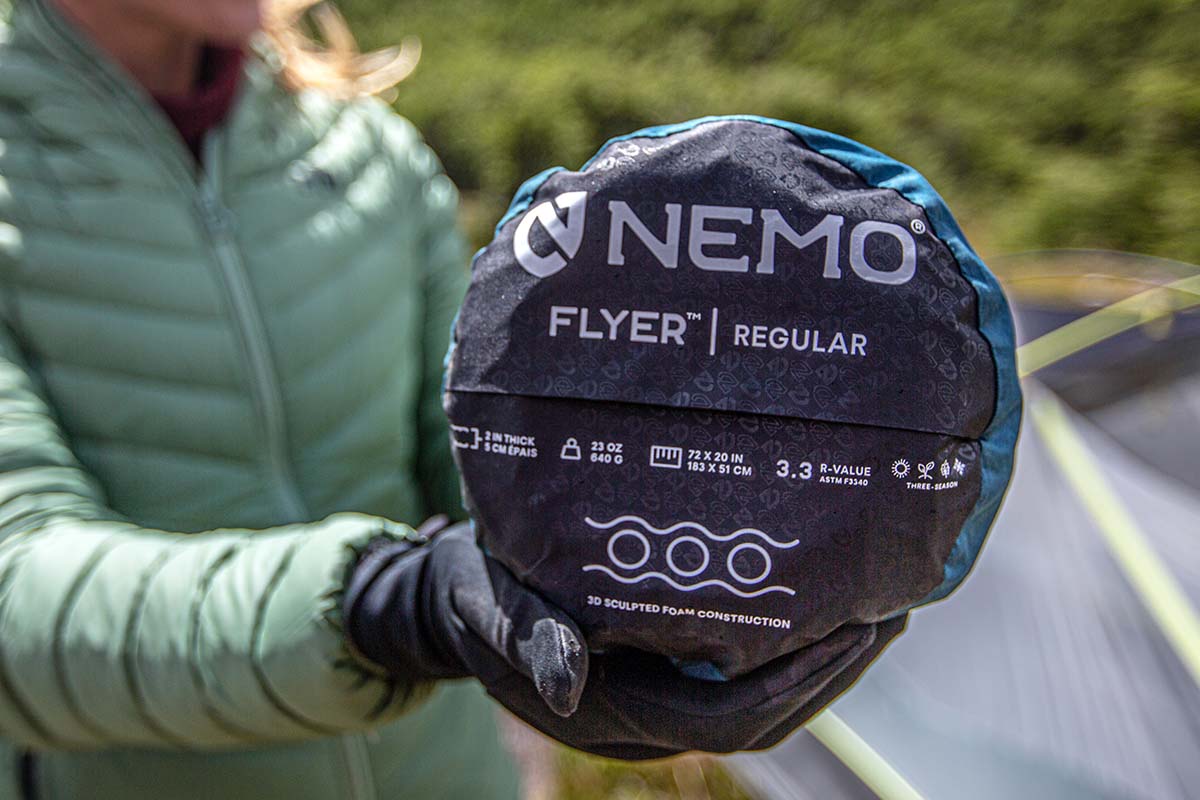
Packed size is a function of the pad type, amount of insulation, and fabric thickness. Uninsulated or lightly insulated air pads are far and away the most compact. Some even compress to the size of a can of soda, which is a far cry from the foam and self-inflating pads that dominated the market only a decade ago. A quick scan of our comparison table above shows that most air pads, even warm options like the Therm-a-Rest XTherm NXT, pack down small enough to easily fit inside a backpacking pack. Designs like the XLite NXT pack down impressively small and can be gripped in one hand.

If you are considering a self-inflating or closed-cell foam pad, packed size can present a problem. A foam option like Therm-a-Rest Z Lite is 20 inches long (most air pads are about 7 to 10 inches), which means you’ll need to strap it to the outside of your pack. Self-inflating pads can have similar issues, although modern designs like the Nemo Flyer (6.5 x 10 in.) are reasonably small and should be workable for storing inside most bags. For some, packed size may not be an issue at all, but it’s one of a number of reasons why air pads have become so popular.
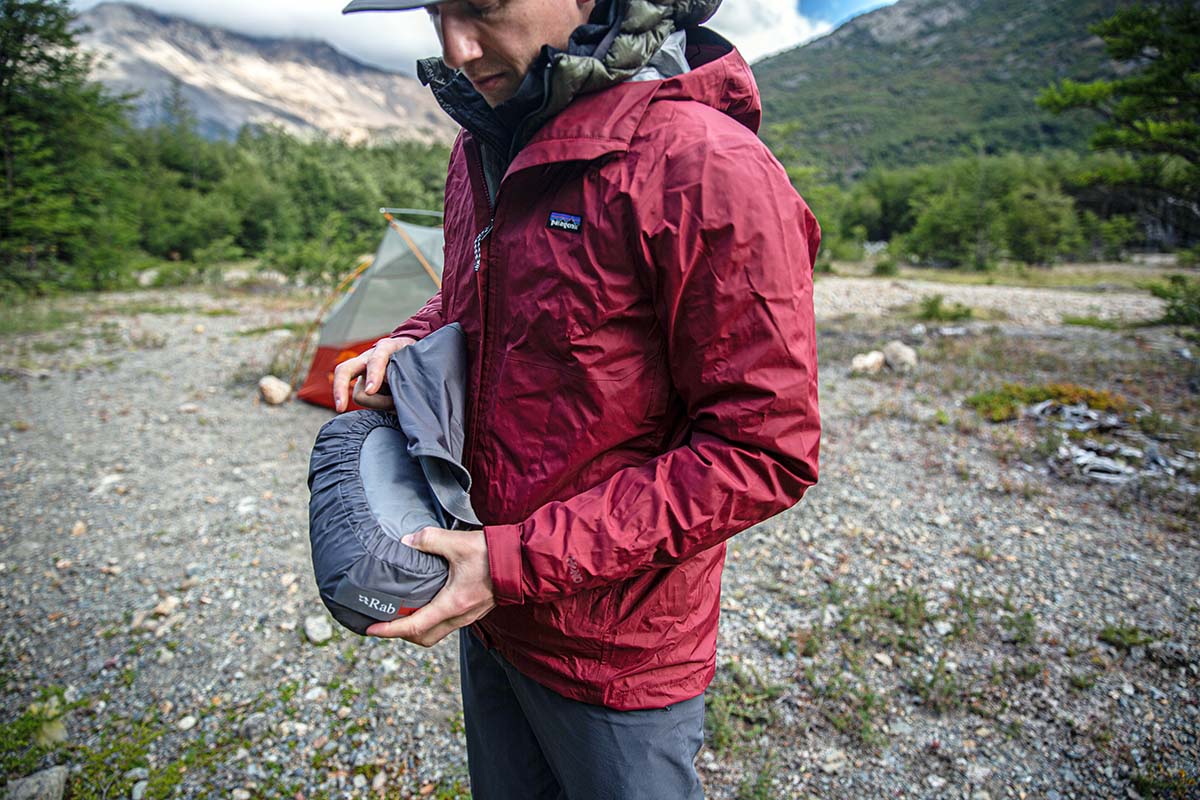
Most sleeping pads are unisex and come in two or three sizes that allow you to choose based on your height and comfort preferences. A “regular” pad is generally right around 72 inches long and 20 inches wide (at its widest point), and the “large” is often between 77 and 80 inches long and 25 inches wide. In terms of shape, they fall into two basic categories: Mummy pads that taper towards the feet to cut weight, and rectangular pads that are more spacious and accommodating for comfort-minded or active sleepers.
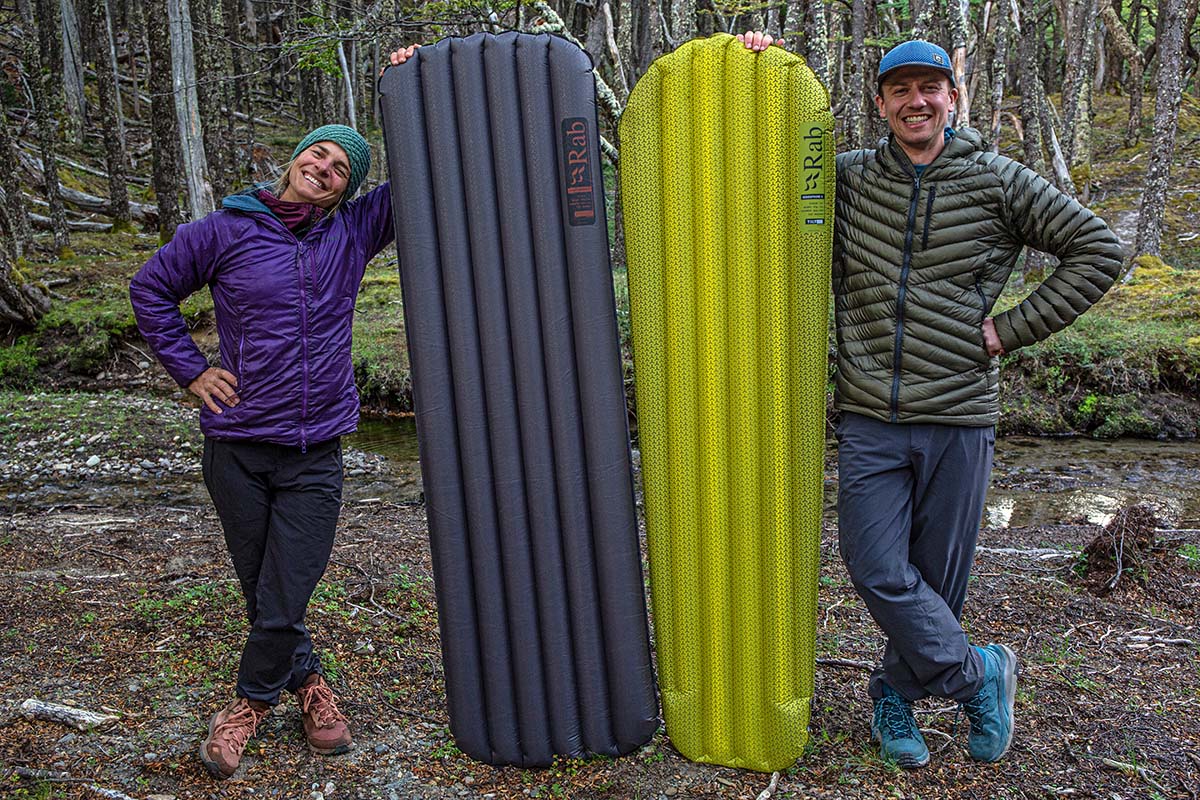
Occasionally you’ll find a “small” size, and some brands even offer torso pads that are only about 2/3 the length of a regular pad. These aren’t the most comfortable models, but they do allow you to cut significant weight. Because your legs have fewer contact points with the ground, some people don’t mind the short length (and they sometimes throw an extra piece of gear under their feet for cushioning and warmth). On the other end of the spectrum are two-person pads like the Exped Ultra 3R Duo. Measuring 41.3-inch width at the head and 32.3-inch width at the feet, it takes up nearly the entire tent floor to eliminate any possible gaps. Realistically, a double pad is fairly impractical as it’s heavy and bulky to pack, but it can be a fun option for couples and small families. See our section on two-person pads above for our take on these unique designs.

Some sleeping pads also come in a women’s version that looks nearly identical to its unisex counterpart—so what’s the difference? To start, they’re usually a bit shorter, since they’re designed with average female body proportions in mind. Many also have a higher R-value (or more insulation), making them a solid pick for any shorter adult who tends to sleep cold, regardless of gender. In addition, manufacturers often modify the foam distribution to better support areas like the hips and torso, where women tend to have more contact with the pad. Some models even include slight adjustments in shape or width for improved comfort and warmth retention.
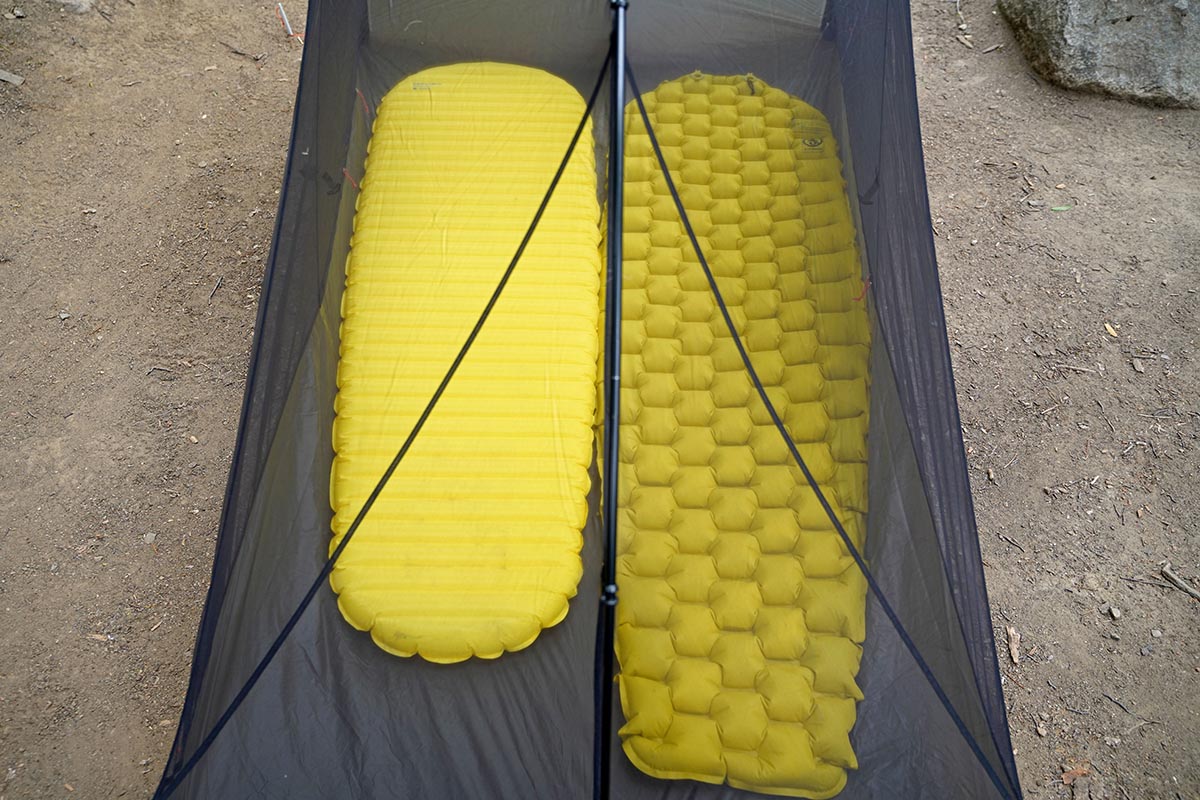
The most common measure of durability in the outdoor gear world is denier (D), which measures the thickness of a fabric. The higher the denier, the tougher the material will be. Let us be clear: Denier matters, and you can feel the difference. So does weight, however, so it’s important to find the right balance for your backpacking style. Ultralight backpackers cut every possible ounce and usually know how to take care of their gear (otherwise it would be an extremely expensive hobby, if it isn’t already). The downside is that lower-denier fabrics have shorter lifespans and a higher propensity for durability issues in the backcountry. On our list above, thickness ranges from the 20-denier Nemo Flyer to the 75-denier (and heavier) Rab Stratosphere 4.

Both air and self-inflating sleeping pads utilize a valve to inflate/deflate, and there have been a fair number of changes in the designs over the past few years. Traditional sleeping pads open and close by twisting and pushing or pulling a round plastic valve connected to the side of the mat. These work pretty well in general, and they’re still used on some old and budget-oriented designs, but there are downsides. For one, the valve works inefficiently because it’s completely open while inflating, which allows some air to escape in between breaths. Further, their upright profile takes up space when rolled up, and they are slow to deflate.

To address these issues, a number of manufacturers including Sea to Summit, Nemo, and Big Agnes have turned to flat valves. Beyond the slim profile, they often have dedicated openings for inflating and deflating, and importantly, a flap that keeps air from escaping while blowing into the opening. We've found these pads with two separate valves for inflating and deflating to be reliable, efficient (it takes about 10 breaths total to inflate and deflation is almost instantaneous), and add essentially no weight—all excellent characteristics.

Moreover, most of Therm-a-Rest's new offerings feature their WingLock valve, which is a twist on a more traditional design. Their new build allows for one-way inflation—with no air loss between breaths—and twisting the side “wings” quickly release air. In use, we’ve found it’s not as fast as the flat valve competition, but its sturdy build and replaceability (something that’s not typically possible with a flat valve) make it worth the trade-off in efficiency for high-volume users like thru-hikers.
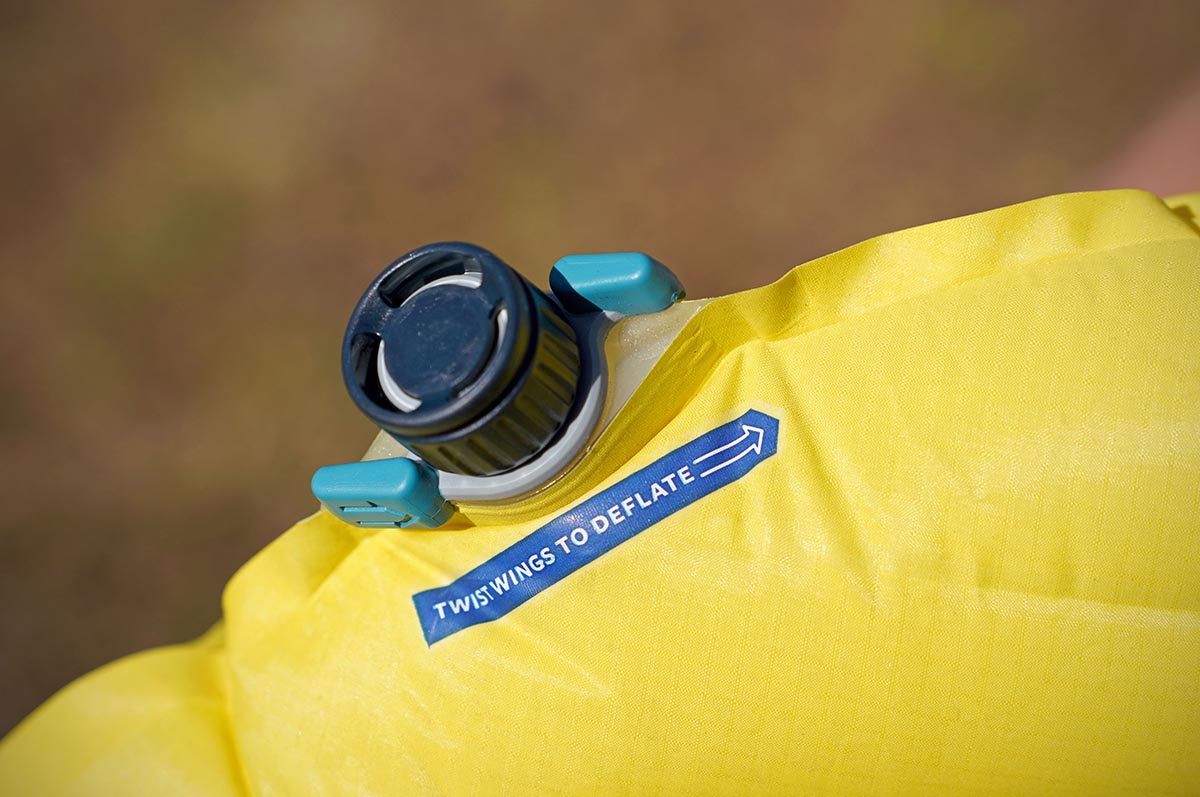
A number of air pads on our list come with dedicated pump bags, which offer a host of benefits over a standard inflation valve. Most notably, pump sacks allow you to save your breath, cut down on inflation time, and prevent moisture from getting inside your pad (which can lead to mold if not dried out properly or even freeze on particularly cold nights). And in many cases, the pump bag doubles as the pad’s stuff sack, which means you’re not adding any weight by gaining this convenience.

That said, not all pump sacks are created equally, and some designs are much more functional and convenient to use than others. For example, we’ve found that the Nemo Tensor’s Vortex pump sack is incredibly efficient and user-friendly: Simply snap the Vortex onto the pad’s flat inflation valve, blow lightly into the open bag, then roll the collar down and push the trapped air into the mat. Sea to Summit includes a similar system with models like their Ether Light XT and Comfort Light Insulated, and we’ve found it takes only around three or four full bags to inflate the pads. On the flip side, Therm-a-Rest’s pump sack is a little less intuitive and takes longer to fill their NeoAir models. To be fair, the differences are fairly minimal, and we always appreciate saving time and breath after a long day on the trail.
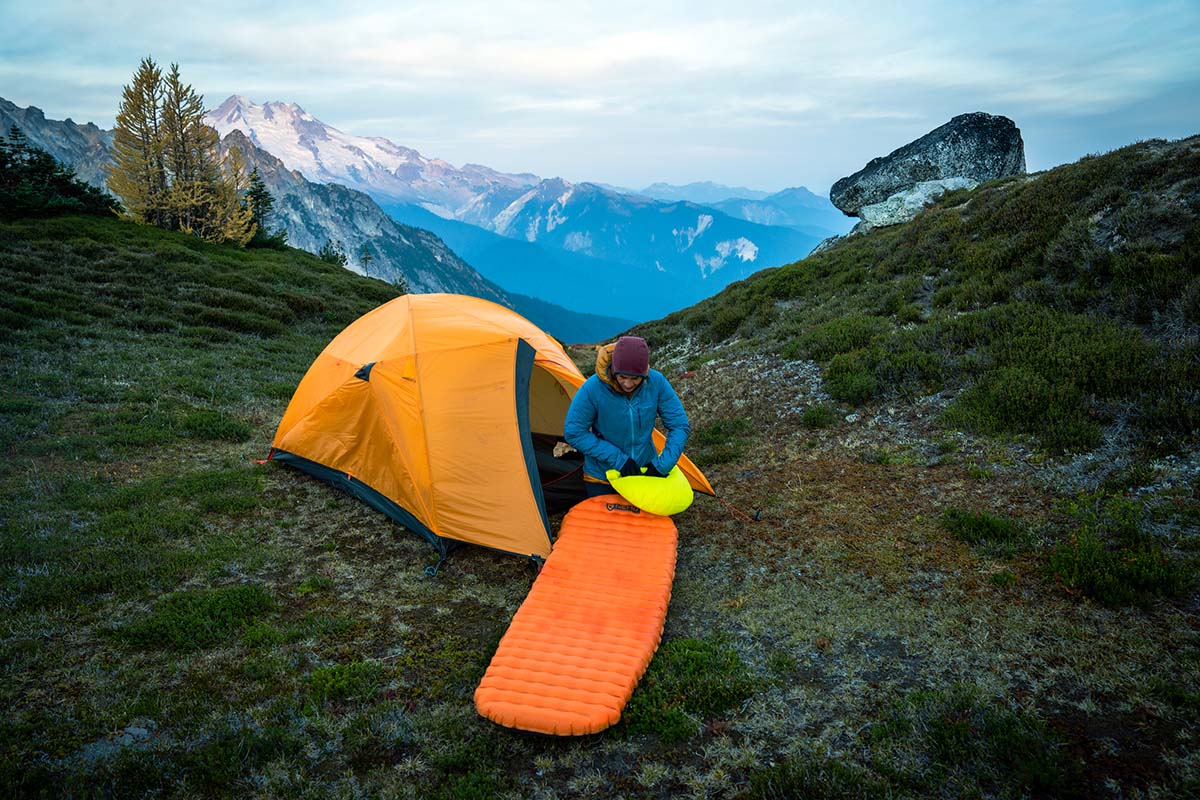
The outdoor industry as a whole has seen a sizable uptick in the use of sustainable practices in recent years, and the sleeping pad space is no exception. Two of the most common measures are recycled fabrics and bluesign-approved materials that have met strict safety and environmental requirements to be deemed safe for workers, consumers, and the environment. Nemo is one brand at the forefront of the sustainability push, and both their Flyer and Quasar pads above use recycled and bluesign-certified fabrics. Big Agnes also employs recycled nylon for their Divide and Zoom UL pads, while Exped’s Ultra 7R uses recycled polyester. A final way to shop sustainably is to purchase from a Climate Neutral Certified brand like REI Co-op that works to offset their carbon emissions.

If you are like most backpackers, you don’t head out year-round. To store a self-inflating pad in the offseason, make sure to leave it unrolled and the valve(s) open. By doing this you’ll keep the foam in good shape. If it’s stored compressed, the pad will lose its self-inflating nature because the foam will become overly compacted. Having a hard time finding a spot to store the pad? Under a bed or behind a couch are popular options.
Air pad storage and care is a little simpler. Remove all the air from the pad and keep it rolled up in its storage bag to protect it from punctures. As for caring for a closed-cell foam pad—try to not let your dog eat it, how about that? But seriously, it's not much harder than that. Don’t leave heavy objects on top of it to avoid undue compressing of the foam, and (if it’s a rollable type) store it unrolled so it doesn’t lose its shape.
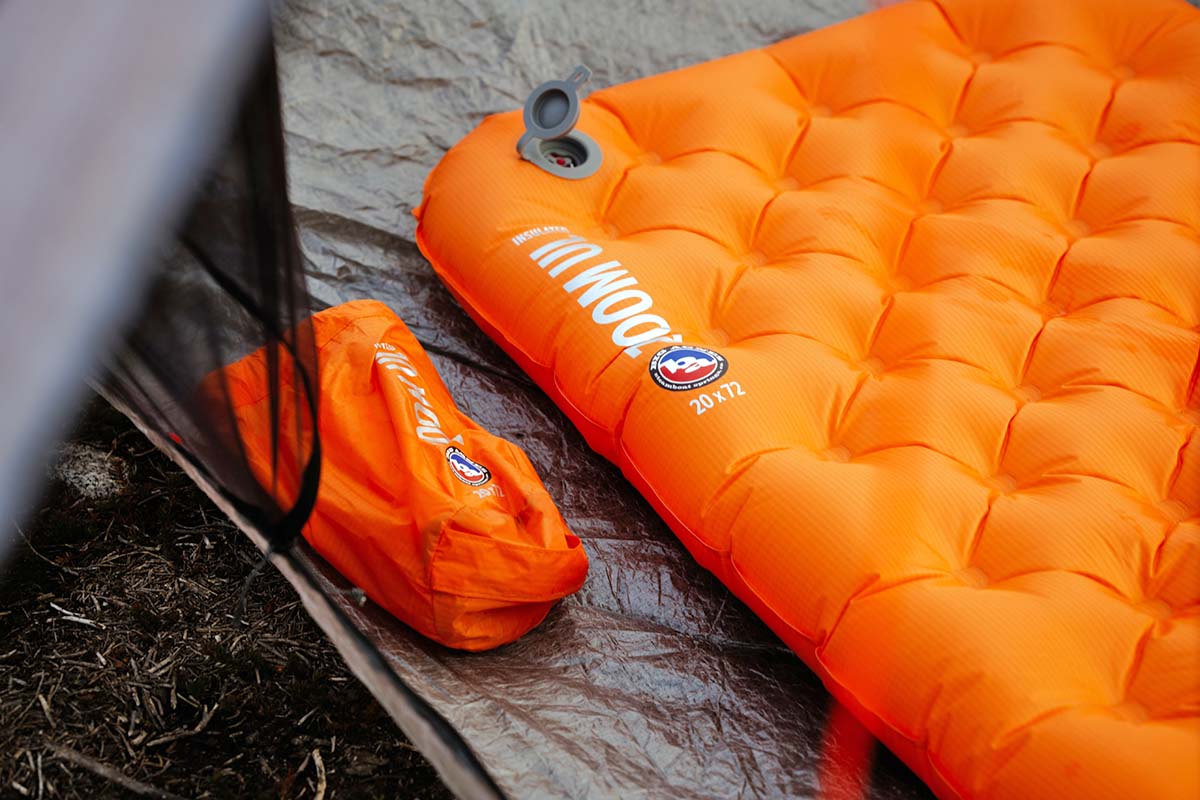
Sleeping pads for backpacking are light, pack down small, and are reasonably comfortable. But if you don’t plan on venturing far from the car, we recommend a thicker and more luxurious camping mattress instead. These mats are plush and warm, often layered with extra foam padding. They’re also a whole lot more durable because the manufacturers don’t have to use thin materials as a means to keep weight down. To see our full list of favorites and a breakdown of important features, check out our article on the best camping mattresses and pads.
Back to Our Top Sleeping Pad Picks Back to Our Sleeping Pad Comparison Table